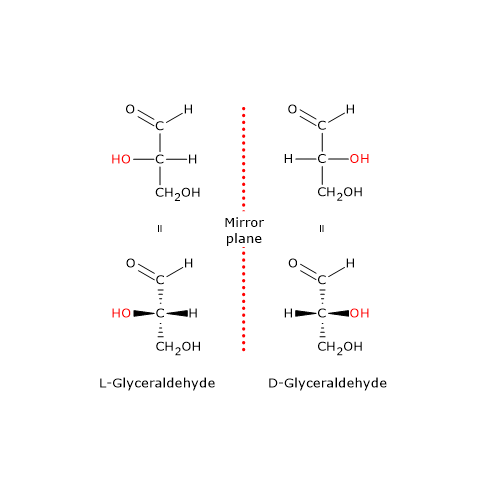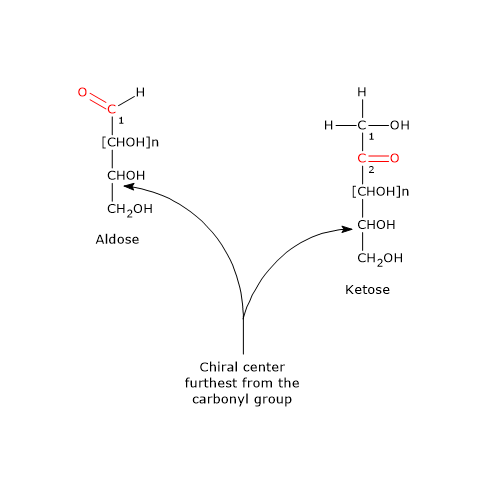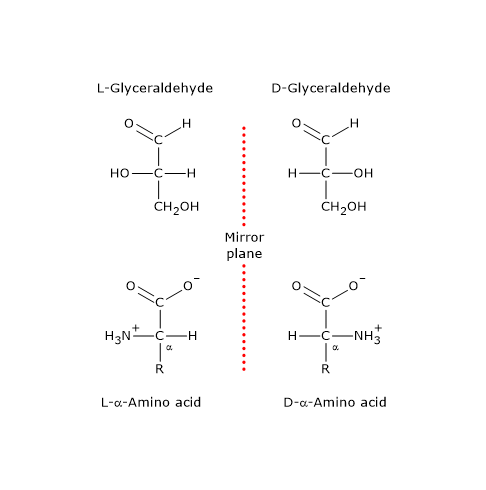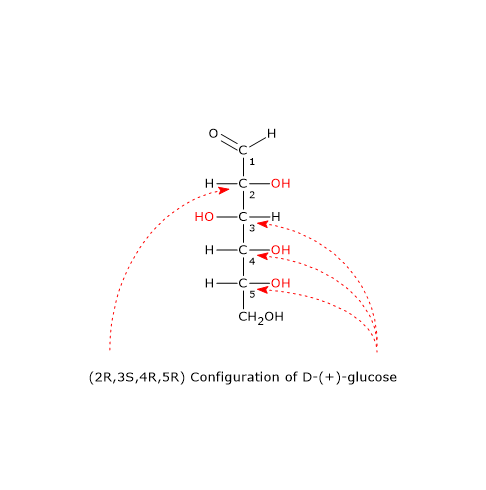In 1906, Russian-American chemist Martin André Rosanoff, then working at New York University, selected glyceraldehyde, a simple monosaccharide, as the standard for denoting the stereochemistry of molecules with at least one chiral center, such as carbohydrates. This nomenclature system became known as the Fischer-Rosanoff convention (or simply the D-L system).[1]
Contents
- Fischer-Rosanoff convention: origin and application
- Fischer-Rosanoff convention: carbohydrates
- Fischer-Rosanoff convention: α-amino acids
- Relative and absolute configurations
- Ambiguities of the Fischer-Rosanoff convention
- References
Fischer-Rosanoff convention: origin and application
Since the absolute configuration of glyceraldehyde was unknown at the time, Rosanoff assigned the stereochemistry in an entirely arbitrary way:
- The D prefix (from the Latin dexter, meaning “right”) was assigned to (+)-glyceraldehyde, the dextrorotatory enantiomer, assuming that its Fischer projection had the hydroxyl group (–OH) on the right side of the chiral center.
- The L prefix (from the Latin laevus, meaning “left”) was assigned to (−)-glyceraldehyde, the levorotatory enantiomer, assuming the hydroxyl group was on the left side of the chiral center.[2]

Although Emil Fischer himself rejected this system, it was widely adopted for determining the relative configurations of chiral molecules. How? By chemically converting a molecule into a derivative of glyceraldehyde using reactions that retain the configuration, meaning no bonds to the chiral center are broken, the spatial arrangement around the chiral center is preserved.[3]
The Fischer-Rosanoff convention allows chemists to classify chiral molecules, such as amino acids and monosaccharides, into two categories: the D series and the L series, depending on whether their configuration corresponds to that of D- or L-glyceraldehyde.
Note: there is no direct correlation between configuration (D or L) and the direction of optical rotation. The D–L system does not indicate whether a molecule is dextrorotatory or levorotatory; it only relates molecular configuration to that of glyceraldehyde.[4]
Fischer-Rosanoff convention: carbohydrates
Monosaccharides can be classified as either aldoses or ketoses. Aldoses, and ketoses with more than three carbon atoms, have at least one chiral center. By convention, they are assigned to the D or L series depending on the configuration of the chiral carbon farthest from the carbonyl group, which is the carbon with the highest oxidation state. If this configuration matches that of D-glyceraldehyde or L-glyceraldehyde, the molecule is placed in the corresponding D or L series.
In Fischer projections, the longest carbon chain is drawn vertically, and the carbon atoms are numbered so that the carbonyl carbon receives the lowest possible number: C-1 in aldoses and C-2 in ketoses.[5]
 Note: in nature, D-sugars are far more common than L-sugars.
Note: in nature, D-sugars are far more common than L-sugars.
When it is necessary to specify the optical rotation of a monosaccharide, the prefixes (+) or (–) can be added to the D or L designation. For example, fructose, which is levorotatory, can be written as D-(–)-fructose, whereas glucose, which is dextrorotatory, can be written as D-(+)-glucose.
Fischer-Rosanoff convention: α-amino acids
Amino acids can be classified based on the position of the amino group (–NH2) relative to the carboxyl group (–COOH):
- α-amino acids: the amino group is attached to the α-carbon;
- β-amino acids: the amino group is attached to the β-carbon;
- γ-amino acids: the amino group is attached to the γ-carbon;
- δ-amino acids: the amino group is attached to the δ-carbon.

α-Amino acids are assigned to the D or L series based on the configuration of the four groups attached to the α-carbon, the chiral center: –NH2, –COOH, –R, and –H. If their spatial arrangement matches that of the hydroxyl, aldehyde (–CHO), hydroxymethyl (–CH2OH), and hydrogen atoms in D- or L-glyceraldehyde, the amino acid belongs to the corresponding series.[4]
In Fischer projections, amino acids are represented with the carboxyl group, the carbon with the highest oxidation state, at the top, and the R group at the bottom.
Among α-amino acids, the proteinogenic amino acids (those involved in protein synthesis), with the exception of glycine, whose α-carbon is not chiral, all exhibit the L configuration, and are thus known as L-α-amino acids.
Note: in nature, L-α-amino acids are significantly more abundant than other types of amino acids, which do not participate in protein synthesis.[5]
Relative and absolute configurations
When Rosanoff arbitrarily assigned the D prefix to (+)-glyceraldehyde and the L prefix to (–)-glyceraldehyde, he had a 50/50 chance of being correct.[6]
In the early 1950s, the development of X-ray diffraction analysis made it possible to determine the absolute configuration of chiral molecules. In 1951, Dutch chemist Johannes Martin Bijvoet established the absolute configuration of sodium rubidium (+)-tartrate tetrahydrate. By comparing it with glyceraldehyde, he demonstrated that Rosanoff’s assumption was correct.
As a result, the configurations of chiral compounds previously assigned relative to glyceraldehyde turned out to match their true absolute configurations, meaning that the relative configurations became absolute configurations.[7]
Ambiguities of the Fischer-Rosanoff convention
The Fischer-Rosanoff convention can lead to ambiguities when applied to molecules with more than one chiral center. For example, in D-(+)-glucose, the D–L system provides information only about the configuration at C-2, but gives no indication regarding the other chiral centers, namely C-3, C-4, and C-5.[3]

In such cases, the RS system, developed in 1956 by Robert Sidney Cahn, Christopher Ingold, and Vladimir Prelog, offers a more precise description by assigning a configuration to each chiral center individually. For instance, D-(+)-glucose has the configuration (2R,3S,4R,5R).[5][8]
It should also be noted that the D or L designation depends on which chiral center is chosen as the reference point. Consequently, the same molecule can sometimes be classified as either D or L, depending on the structural context.
References
- ^ Rosanoff M.A. On Fischer’s classification of stereo-isomers. J Am Chem Soc 1906:28(1);114-121. doi:10.1021/ja01967a014
- ^ IUPAC. Compendium of Chemical Terminology, 2nd ed. (the “Gold Book”). Compiled by A. D. McNaught and A. Wilkinson. Blackwell Scientific Publications, Oxford (1997). Online version (2019-) created by S. J. Chalk. ISBN 0-9678550-9-8. doi:10.1351/goldbook
- ^ a b Garrett R.H., Grisham C.M. Biochemistry. 4th Edition. Brooks/Cole, Cengage Learning, 2010.
- ^ a b Nelson D.L., Cox M.M. Lehninger. Principles of biochemistry. 8th Edition. W.H. Freeman and Company, 2021.
- ^ a b c Voet D. and Voet J.D. Biochemistry. 4th Edition. John Wiley J. & Sons, Inc. 2011.
- ^ Moran L.A., Horton H.R., Scrimgeour K.G., Perry M.D. Principles of Biochemistry. 5th Edition. Pearson, 2012.
- ^ Bijvoet J.M., Peerdeman A.F., Van Bommel A.J. Determination of the absolute configuration of optically active compounds by means of X-rays. Nature 1951;168(4268):271. doi:10.1038/168271a0
- ^ Cahn R.S., Ingold C., Prelog V. Specification of molecular chirality. Angew Chem 1966:5(4); 385-415. doi:10.1002/anie.196603851